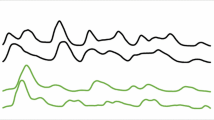Abstract
The variation in electromyographic output of twelve trigeminal muscles of the rabbit was studied to test the hypothesis that they are under the control of a small number of independent neural factors. Jaw muscle electromyograms (EMGs) of eight animals were recorded in 95 chewing sequences, each consisting of 40–75 chewing cycles. The within-sequence correlations of the EMG burst amplitudes (integrated per cycle) and burst onsets were calculated between the muscles. The correlation matrix was subjected to a principal components analysis. This method aims at describing the variation in EMG amplitude and timing by means of the smallest possible set of newly defined variables, or principal components. Of the variation in EMG amplitude values of the twelve muscles, 75–90% could be accounted for by only three principal components. Each principal component was characterized by a group of muscles with high mutual positive correlations; they had zero correlation with other principal components. The first component represents the jaw closers: most of the bilateral masseter and the medial pterygoid muscles. The second represents the openers: the bilateral digastric and lateral pterygoid muscles. This demonstrates the tight control of both the jaw openers and closers, each by a single neural factor; these two factors are independent of one another. They most likely originate from the specific inputs from primary afferents to the opener and closer motoneurons. Unexpectedly, a third independent principal component appeared to control the closing activity of the non-chewing side, posterior deep masseter muscle. It was hypothesized that this muscle acts independently of the other closers to disengage the teeth and resets the jaw for a new chewing cycle. Principal components analysis of variation in timing of EMG onset revealed a grouping of all masticatory muscles in a single cluster, independent of EMG amplitude. This supports the hypothesis that timing and amplitude of masticatory EMG patterns are controlled independently.
Similar content being viewed by others
Author information
Authors and Affiliations
Additional information
Received: 16 January 1998 / Accepted: 15 March 1999
Rights and permissions
About this article
Cite this article
Weijs, W., Sugimura, T. & van Ruijven, L. Motor coordination in a multi-muscle system as revealed by principal components analysis of electromyographic variation. Exp Brain Res 127, 233–243 (1999). https://doi.org/10.1007/s002210050793
Issue Date:
DOI: https://doi.org/10.1007/s002210050793




